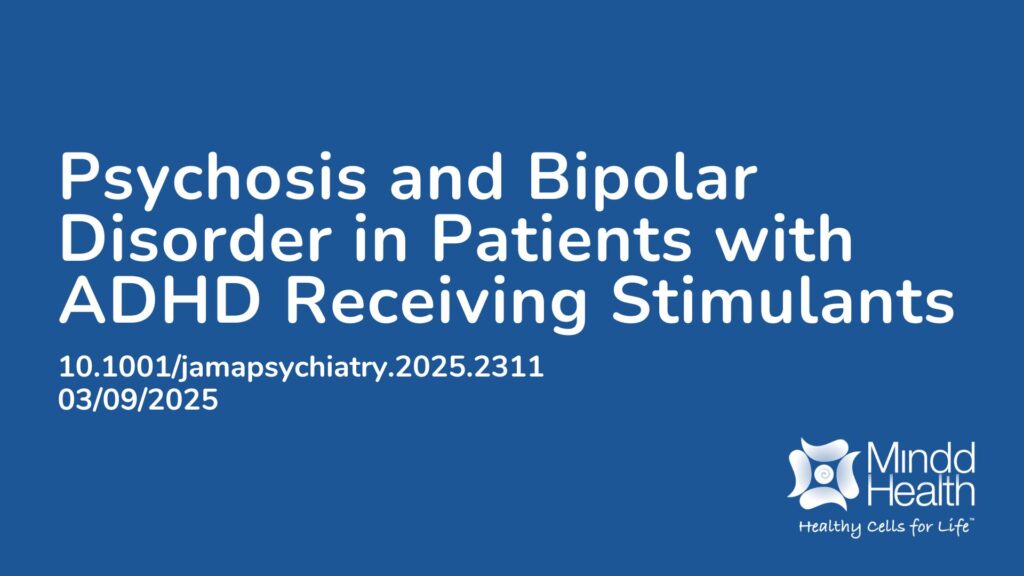Summary:
This systematic review and meta-analysis assessed whether people with Attention-Deficit/Hyperactivity Disorder (ADHD) who receive stimulant medication are more likely to develop psychosis or bipolar disorder (BD). A total of 16 studies involving 391,043 participants were included. Across studies, psychotic symptoms occurred in about 2.8% of individuals, psychotic disorders in 2.3%, and BD in 3.7%. Amphetamines carried a higher risk of psychosis compared with methylphenidate, with odds of psychosis about 1.6 times greater. Risk was also influenced by factors such as study location, follow-up duration, dose of stimulants, sex distribution, and sample size. For example, studies from North America and those with longer follow-up periods reported higher rates of psychotic symptoms, and increased risk was associated with higher doses and a greater proportion of female participants. These findings show that while relatively uncommon, psychosis and BD do occur in a notable proportion of individuals with ADHD treated with stimulants, particularly amphetamines. The results do not prove that stimulants cause these outcomes, but they indicate the need for careful monitoring and patient education. The authors concluded that clinicians prescribing stimulants should discuss these risks with patients and monitor for emerging psychiatric symptoms during treatment. Further research, including randomized controlled trials and direct comparisons between individuals exposed and not exposed to stimulants, is needed to clarify causal links and better guide clinical decision-making.
Abstract:
Importance Individuals with attention-deficit/hyperactivity disorder (ADHD) may present with psychosis or bipolar disorder (BD) following treatment with stimulants. The extent to which this occurs is currently unclear. Objective To meta-analytically quantify the occurrence of psychosis or BD after exposure to stimulants in individuals with ADHD and assess possible moderating factors. Data Sources PubMed, Web of Science, Ovid/PsycINFO, and Cochrane Central Register of Reviews were searched from inception until October 1, 2024, without language restrictions. Study Selection Studies of any design with DSM or International Classification of Diseases–defined ADHD populations exposed to stimulants, where psychosis or BD outcomes were evaluated. Data Extraction and Synthesis PRISMA Preferred Reporting Items for Systematic Reviews and Meta-analyses and MOOSE Meta-analysis of Observational Studies in Epidemiology guidelines were followed, the protocol was registered, and the Newcastle-Ottawa scale and Cochrane risk of bias-2 tool were used for quality appraisal. Random-effects meta-analysis, subgroup analyses, and meta-regressions were conducted. Main Outcomes and Measures For the proportion of individuals developing psychotic symptoms, psychotic disorders, and BD, effect sizes are reported as percentages with 95% CIs. For the comparison between amphetamines and methylphenidate, effect sizes are presented as odds ratios with 95% CIs. Results Sixteen studies (N = 391 043; mean [range] age, 12.6 [8.5-31.1] years; 288 199 [73.7%] male) were eligible. Among individuals with ADHD prescribed stimulants, 2.76% (95% CI, 0.73-9.88; k = 10; n = 237 035), 2.29% (95% CI, 1.52-3.40; k = 4; n = 91 437), and 3.72% (95% CI, 0.77-16.05; k = 4; n = 92 945) developed psychotic symptoms, a psychotic disorder, and BD, respectively. Heterogeneity across the studies was significant (I2 > 95%). Psychosis occurrence risk was significantly higher in individuals exposed to amphetamines than to methylphenidate (odds ratio [OR], 1.57, 95% CI, 1.15-2.16; k = 3, n = 231 325). Subgroup analyses showed significantly higher prevalence of psychotic symptoms in studies from North America and in those with longer follow-up periods. Increased psychosis occurrence was associated with a higher proportion of female participants, smaller sample sizes, and higher dose of stimulants. Conclusions and Relevance This systematic review and meta-analysis found a nonnegligible occurrence of psychotic symptoms, psychotic disorders, or BD in individuals with ADHD treated with stimulants. Amphetamines were associated with higher occurrence compared to methylphenidate. The included studies cannot establish causality, highlighting the need for further research, including randomized clinical trials and mirror-image studies comparing individuals exposed and not exposed to stimulants. Nonetheless, clinicians should inform patients about the increased occurrence of psychosis or BD when discussing stimulant pharmacotherapy and systematically monitor for these conditions throughout treatment.
Article Publication Date: 03/09/2025
DOI: 10.1001/jamapsychiatry.2025.2311



